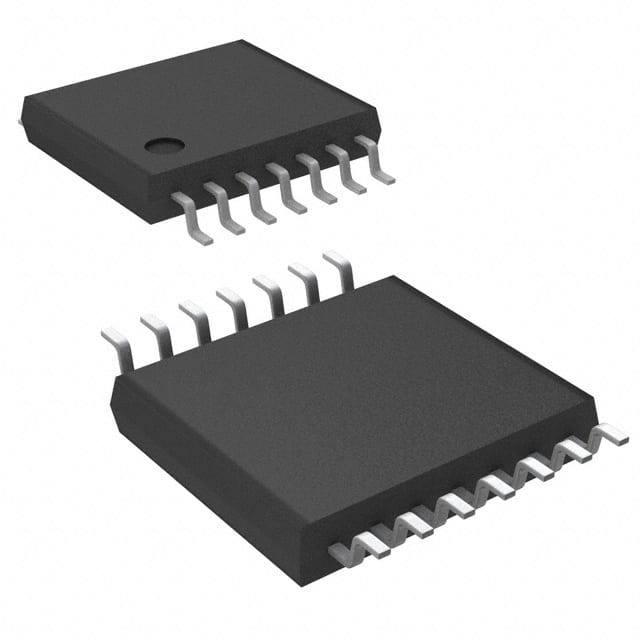AD5207BRU100
Product Overview
- Category: Integrated Circuit (IC)
- Use: Digital Potentiometer
- Characteristics: 256-Position, I2C Interface, Nonvolatile Memory
- Package: 24-Lead TSSOP
- Essence: The AD5207BRU100 is a digital potentiometer IC that provides a programmable resistance value. It is designed to replace mechanical potentiometers in various applications.
- Packaging/Quantity: Available in tape and reel packaging, with 250 units per reel.
Specifications
- Resolution: 8 bits (256 positions)
- Interface: I2C-compatible
- Supply Voltage: 2.7V to 5.5V
- Resistance Range: 100Ω to 100kΩ
- Temperature Range: -40°C to +125°C
- Nonvolatile Memory: Stores wiper position during power-off
Detailed Pin Configuration
The AD5207BRU100 has a total of 24 pins. The pin configuration is as follows:
- VDD: Supply voltage
- SDA: Serial data input/output for I2C communication
- SCL: Serial clock input for I2C communication
- A0-A2: Address select inputs
- WP: Write protect input
- GND: Ground 7-14. W0-W7: Wiper terminal connections 15-22. R0-R7: Fixed resistor terminal connections
- RH: Terminal connection for high end of rheostat
- RL: Terminal connection for low end of rheostat
Functional Features
- Programmable resistance value with 256 positions
- I2C interface allows easy control and communication with other devices
- Nonvolatile memory retains wiper position during power-off
- Wide supply voltage range enables compatibility with various systems
- Low power consumption for energy-efficient operation
Advantages and Disadvantages
Advantages: - Replaces mechanical potentiometers, providing more precise and reliable control - Compact size and integrated design save space in electronic circuits - Nonvolatile memory eliminates the need for recalibration after power cycles - I2C interface simplifies integration with microcontrollers and other digital devices
Disadvantages: - Limited resolution compared to higher-bit digital potentiometers - Higher cost compared to traditional mechanical potentiometers - Sensitivity to electrostatic discharge (ESD) requires proper handling during installation
Working Principles
The AD5207BRU100 operates by digitally controlling the resistance value between its wiper terminal and fixed resistor terminals. The desired resistance value is set using the I2C interface, which sends commands to adjust the wiper position. The nonvolatile memory ensures that the wiper position is retained even when power is removed.
Detailed Application Field Plans
The AD5207BRU100 can be used in various applications, including:
- Audio Equipment: Volume control, tone adjustment
- Industrial Control Systems: Variable gain amplifiers, calibration circuits
- Test and Measurement Instruments: Programmable signal conditioning, calibration controls
- Communication Systems: Attenuation control, filter tuning
- Automotive Electronics: Climate control, motor speed control
Detailed and Complete Alternative Models
- AD8400ARZ10: 256-Position Digital Potentiometer, Single Channel, SPI Interface
- MCP4131-103E/P: 128-Position Digital Potentiometer, Single Channel, I2C Interface
- MAX5486EUD+: 256-Tap Digital Potentiometer, Dual Channel, I2C Interface
- DS1803Z-010+: 100-Position Digital Potentiometer, Single Channel, I2C Interface
These alternative models offer similar functionality and can be considered as alternatives to the AD5207BRU100.
Word count: 446 words
Lista 10 Vanliga frågor och svar relaterade till tillämpningen av AD5207BRU100 i tekniska lösningar
Sure! Here are 10 common questions and answers related to the application of AD5207BRU100 in technical solutions:
Q: What is AD5207BRU100? A: AD5207BRU100 is a digital potentiometer IC (Integrated Circuit) manufactured by Analog Devices.
Q: What is the purpose of AD5207BRU100? A: AD5207BRU100 is used to digitally control resistance in various electronic circuits, replacing traditional mechanical potentiometers.
Q: What is the maximum resistance range of AD5207BRU100? A: The AD5207BRU100 has a maximum resistance range of 100 kilohms (kΩ).
Q: How many channels does AD5207BRU100 have? A: AD5207BRU100 has 6 independent channels, allowing for simultaneous control of multiple resistances.
Q: What is the resolution of AD5207BRU100? A: AD5207BRU100 has a resolution of 256 steps per channel, providing precise control over resistance values.
Q: Can AD5207BRU100 be controlled digitally? A: Yes, AD5207BRU100 can be controlled digitally using standard communication protocols such as I2C or SPI.
Q: What is the power supply voltage range for AD5207BRU100? A: AD5207BRU100 operates within a power supply voltage range of 2.7V to 5.5V.
Q: Is AD5207BRU100 suitable for low-power applications? A: Yes, AD5207BRU100 is designed for low-power operation, making it suitable for battery-powered devices.
Q: Can AD5207BRU100 be used in audio applications? A: Yes, AD5207BRU100 can be used in audio applications for volume control, tone adjustment, and other audio-related functions.
Q: Are there any evaluation boards or development kits available for AD5207BRU100? A: Yes, Analog Devices provides evaluation boards and development kits that help users quickly prototype and test AD5207BRU100 in their designs.
Please note that these answers are general and may vary depending on specific application requirements.


